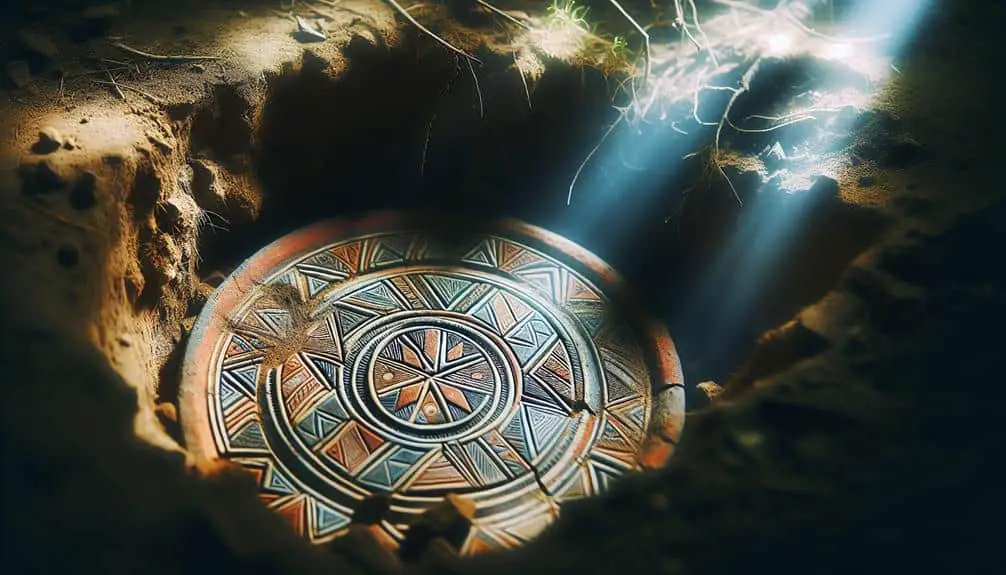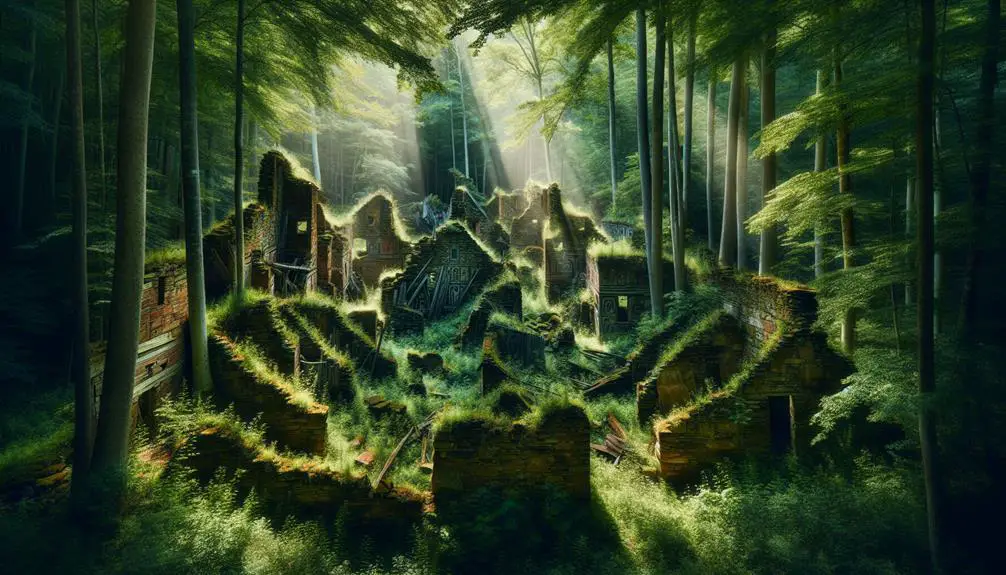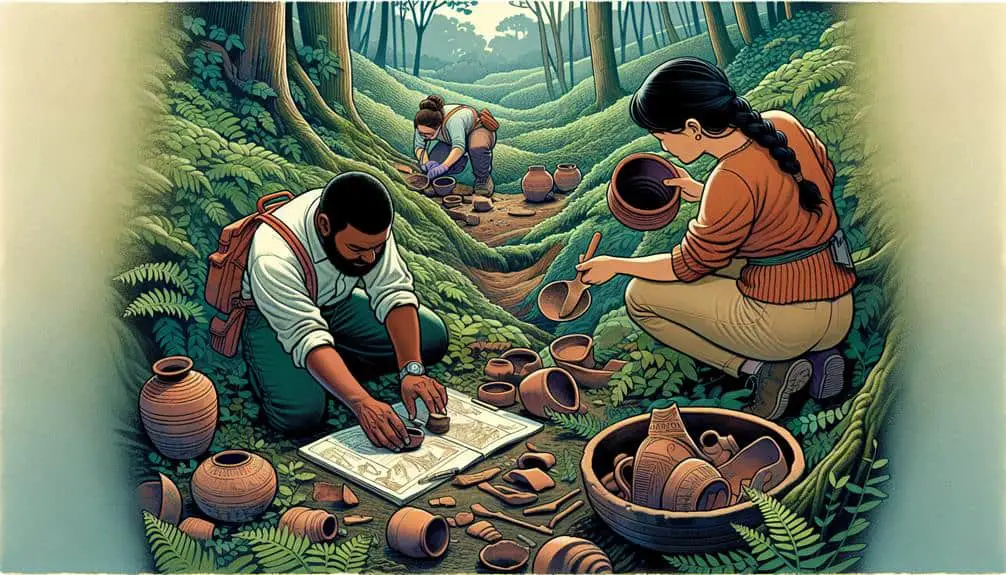Uncovering hidden Native American settlement artifacts in the US offers a unique look into the past, revealing insights into ancient traditions, beliefs, and societal structures. Excavating these artifacts provides tangible connections to the daily lives of indigenous communities, shedding light on their cultural heritage and craftsmanship. The artifacts not only showcase technological advancements and artistic styles but also play an essential role in historical preservation. Each discovery contributes to honoring and respecting the profound legacy of Native American tribes, offering a deeper understanding of their rich history and cultural significance. Discover more about these intriguing findings and their impact on heritage preservation.
Key Points
- Uncovering hidden settlement remnants reveals lost aspects of Native American history.
- Tools and pottery discoveries offer insights into daily life and craftsmanship.
- Preservation efforts face challenges like degradation risks and limited funding.
- Future prospects involve partnerships, innovative technologies, and interdisciplinary studies.
- Engaging local tribes in excavation projects fosters respect for ancestral lands.
Significance of Native American Artifacts
When exploring the significance of Native American artifacts, it becomes evident that these objects hold a wealth of historical and cultural value. The cultural significance of these artifacts lies in their ability to provide insights into the traditions, beliefs, and ways of life of Native American tribes. Through these artifacts, one can trace the evolution of artistic styles, technological advancements, and societal structures within these communities. Additionally, these objects serve as a link to the past, connecting present generations with their ancestors and preserving a sense of cultural continuity.
In terms of historical preservation, Native American artifacts play an important role in documenting and safeguarding the heritage of indigenous peoples. These artifacts offer tangible evidence of past civilizations, helping researchers and historians piece together the narrative of Native American history. By recognizing the historical importance of these artifacts and ensuring their protection, we contribute to a collective effort to honor and respect the cultural legacy of Native American communities.
Uncovering Hidden Settlement Remnants
Exploring hidden settlement remnants provides a captivating opportunity to uncover long-forgotten aspects of Native American history and culture. Through archaeological surveys, researchers can delve into the past and piece together the stories of indigenous communities that once thrived in these areas. These remnants serve as tangible links to the past, shedding light on the daily lives, traditions, and societal structures of Native American tribes.
The discovery of settlement remnants is vital for preserving cultural heritage and understanding the historical significance of these sites. By carefully excavating and studying these artifacts, researchers can gain valuable insights into the ways in which Native American communities interacted with their environment, adapted to changing circumstances, and maintained their cultural identities over time.
Uncovering hidden settlement remnants not only enriches our understanding of Native American history but also highlights the importance of protecting these sites for future generations. By recognizing the significance of these remnants and the stories they hold, we can work towards preserving and honoring the cultural heritage of indigenous peoples across the United States.
Tools and Pottery Discoveries
Delving into archaeological surveys reveals fascinating insights into the tools and pottery discoveries that shed light on the daily lives and craftsmanship of Native American communities in the US. Archaeological findings have unearthed an array of tools used by Native American tribes, such as stone axes, bone tools for hunting and fishing, and pottery vessels for cooking and storage. These discoveries not only provide a glimpse into the technological advancements of these communities but also offer a deeper understanding of their cultural practices and traditions.
The pottery unearthed through these surveys showcases the intricate designs and craftsmanship of Native American artisans. Each pottery piece tells a unique story, reflecting the artistic abilities and cultural significance of these communities. From simple everyday vessels to elaborate ceremonial pieces, these artifacts offer valuable insights into the beliefs and customs of Native American tribes.
Studying these tools and pottery discoveries allows us to appreciate the ingenuity and creativity of Native American societies while honoring their rich heritage and contributions to American history.
Preservation Efforts and Challenges
Preservation efforts for Native American settlement artifacts in the US present a complex and multifaceted challenge requiring strategic planning and collaboration. The challenges faced in conserving these artifacts stem from environmental factors, such as exposure to elements like moisture, sunlight, and temperature fluctuations, which can degrade the materials over time. Additionally, human activities like construction, agriculture, and looting pose significant threats to the preservation of these valuable cultural resources.
Conservation efforts must address these challenges by implementing proper storage facilities with controlled climate conditions, conducting regular monitoring and maintenance, and establishing protocols for artifact handling and display. Collaboration between archaeologists, tribal communities, government agencies, and conservation specialists is essential to guarantee the long-term protection of these artifacts.
Despite ongoing preservation efforts, limited funding, lack of public awareness, and conflicting interests among stakeholders remain as significant obstacles that need to be overcome to safeguard these essential pieces of Native American history for future generations.
Future Prospects and Research Opportunities
Future research opportunities and prospects in the field of Native American settlement artifacts in the US are ripe for exploration and innovation, offering a promising avenue for further understanding and preserving this rich cultural heritage. As you look ahead, consider the following:
- Future Collaborations: Building partnerships with indigenous communities, scholars, and museums can facilitate a more holistic approach to research and interpretation.
- Innovative Technologies: Embracing cutting-edge tools like LiDAR scanning and 3D modeling can revolutionize artifact documentation and analysis.
- Interdisciplinary Studies: Integrating fields such as anthropology, geology, and climatology can provide a detailed view of past indigenous settlements.
- Community Involvement: Engaging local tribes and residents in excavation projects can foster a sense of ownership and respect for ancestral lands.
- Ethical Considerations: Prioritizing ethical practices in research, including repatriation efforts and cultural sensitivity training, is essential for the preservation of Native American heritage.
Frequently Asked Questions
How Do Native American Artifacts Contribute to Our Understanding of Pre-Colonial History in the United States?
When exploring Native American artifacts, you'll see how they enrich understanding of pre-colonial history. Their cultural significance reveals indigenous perspectives, while archaeological techniques provide insights into historical context, offering a deeper appreciation of America's past.
What Methods Are Used to Locate and Identify Hidden Settlement Remnants?
To locate and identify hidden settlement remnants, experts use ground-penetrating radar and conduct archaeological surveys. These methods help uncover buried artifacts and structures, shedding light on pre-colonial history. Remember, "Seek and you shall find."
Are There Any Unique Tools or Pottery Discoveries That Have Been Particularly Significant in Recent Excavations?
When excavating, you may uncover significant discoveries like unique tools or pottery. Innovative technology aids in pinpointing these artifacts. These findings offer valuable insights into the past, shedding light on the lives of Native American communities.
What Are Some of the Biggest Challenges Faced in Preserving Native American Artifacts and Settlement Sites?
Preserving Native American artifacts and settlement sites presents significant challenges. Cultural significance clashes with modern development pressures. Balancing preservation needs against economic growth creates a delicate dance. The struggle to protect these treasures is ongoing.
In What Ways Can Future Research Opportunities Help Further Illuminate the Lives and Cultures of the Native American Populations Who Once Inhabited These Settlements?
Future research opportunities hold the key to revealing deeper cultural insights into the lives of Native American populations. Through advanced technologies and interdisciplinary approaches, these investigations can shed light on the rich histories of these once-inhabited settlements.



